50 years after New York Times v. Sullivan, do courts still value journalists' watchdog role?
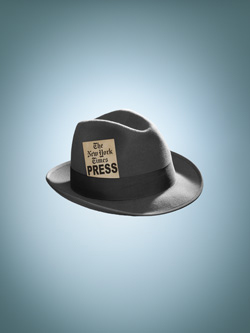
Photo by Mark Hooper
Fifty years ago, in the midst of the change and turmoil associated with the civil rights movement, the U.S. Supreme Court altered the nation’s course on many issues, including the First Amendment.
On March 9, 1964, a unanimous Supreme Court bucked precedent for libel and slander law and, in doing so, widened the scope of First Amendment protection for journalists.
The high court’s ruling in New York Times v. Sullivan forced a larger burden upon public officials pursuing libel or slander cases against the media. The court held that public officials attempting to sue publishers must show that the information disseminated was untrue, and that the publishers either knew the information was false or acted in reckless disregard for the truth.
The holding has become known for establishing the “actual malice” test integral to proving intent in defamation cases. According to legal scholars, the high court’s decision and dicta in Sullivan helped spawn generations of investigative journalists.
The ruling “changed American journalism. It set the stage for the boom in investigative reporting in the decades to follow and truly invigorated the watchdog role of the press,” says Kenneth A. Paulson, president and CEO of the First Amendment Center at the Newseum in Washington, D.C., and dean of the College of Mass Communication at Middle Tennessee State University.
Legal scholars say the cultural significance of Sullivan and its progeny has changed during the past 50 years. The actual-malice test continues to protect reporters and publishers faced with defamation cases. But the question is whether the journalist’s role as government watchdog is still valued and protected by U.S. laws and, particularly, by the judiciary.
Columbia University law professor David Pozen, who specializes in constitutional and national security issues, says that Sullivan and other cases from that era are “seen as valorizing an aggressive form of journalism and promoting the idea that courts are the institutional safeguards of that kind of journalism.”
But he says Sullivan has become more of an “interesting cultural artifact” than a court opinion reflecting how the judiciary views journalists.
“There is still a tendency among members of the media to view the courts in somewhat romantic terms as natural allies and guardians against overreaching by the political branches,” he says. “I’m not confident that remains a descriptively accurate view of the courts.”
“Courts have pulled back on the reporter’s privilege, generally in the national security concept,” adds Pozen. “It’s not at all clear that judges will be protective of journalists’ interests in light of the way judges have handled recent national-security-versus-open-government issues.”
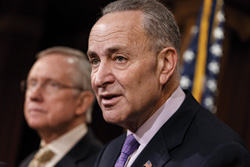
Sen. Charles Schumer is sponsoring a federal media shield law that would restrict circumstances under which a journalist could be forced to testify about confidential sources or information. AP Photo/J. Scott Applewhite
SHADOW OF TERRORISM
Since the Sept. 11, 2001, terrorist attacks, federal investigators have appeared intent on squelching the release of classified information related to national security. And journalists say they have felt the repercussions of the government’s crackdown on leaks.
“Our government, and rightly so, has been trying to make sure that we aren’t attacked again,” says Sophia Cope, director of government affairs and legislative counsel for the Newspaper Association of America in Arlington, Va. “But in doing so they have arguably taken action that maybe the public doesn’t agree with, but has a right to know about.”
“A free press is very important to uncover what the government is doing and hold it accountable,” Cope adds. “To maintain the balance between governmental power and the power of the citizenry, we need accountability reporting—arguably, particularly post-9/11.”
Journalists who have broken stories involving national security have had their email and phone records scrutinized without permission. They have been summoned to testify in court and forced to choose between remaining in jail in contempt of court and revealing the sources for their stories.
Pozen argues that courts have shown an increasing reluctance to side with journalists, particularly when weighing their protection against the interests of national security. In several recent cases involving attempts by the U.S. Department of Justice to gain access to information about confidential sources in national security cases, judges have sided with prosecutors.
On the other hand, Congress is considering a federal media shield law with the goal of protecting journalists from being forced to reveal their sources. Sponsored by Sen. Charles E. Schumer, D-N.Y., the Free Flow of Information Act would narrow the situations under which a journalist could be forced to testify about confidential sources or provide information to law enforcement officials.
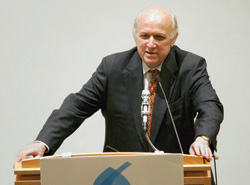
Floyd Abrams, who defended the New York Times in the landmark case, says the case’s First Amendment implications give it “impact beyond the field of libel.” AP Photo/Lawrence Jackson
Supporters of the law say it is imperative for journalists to be able to protect their sources. “About the only area of law relating to free speech and free press in which we lag behind the rest of the democratic world is in the area that relates to the protection of confidential sources,” says Floyd Abrams, a nationally known expert on First Amendment law who defended the New York Times in Sullivan. “A federal shield law is needed and has been needed for some years. It is important that Congress, which can agree on almost nothing, agree on this and adopt shield-law protection.”
However, critics are concerned that the Free Flow of Information Act would encourage judicial overreaching and, further, that it contains an ambiguous definition of a journalist. “The bill is … fraught with near-meaningless ambiguity, and it transfers from the executive to the judiciary the power to determine what is necessary to protect the security of the nation,” wrote former U.S. Attorney General Michael B. Mukasey in a December editorial in the Wall Street Journal.
Others worry that the act’s definition of a “covered” journalist as an individual who works for a news-gathering medium with the “primary intent” of seeking information overlooks citizens who dig into important stories. Certainly, this country has a deep and complex history of investigative reporting, as well as an ingrained appreciation for the free flow of information.
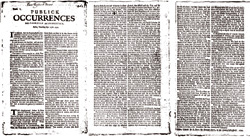
America’s first multi-page newspaper appeared in September 1690 but was quashed by British authorities after one issue because of its allegations of prisoner abuse and sexual improprieties in France. Photo courtesy of Wikipedia.
EARLY EXPOSÉS
The first newspaper published in America was printed in 1690 in Boston. It was a local paper that discussed “barbarous” human rights abuses involving French prisoners of war and an alleged sex scandal involving the king of France. British authorities shut down the newspaper after its first issue.
During the years leading up to the American Revolution, newspapers and pamphlets were often used to challenge British rule and expose the wrongdoing of British colonial leaders. As every law student knows, the country’s founding fathers wanted to ensure a free press. The First Amendment specifically forbids Congress from making any law “abridging the freedom of speech, or of the press.” The 14th Amendment, and subsequent court rulings, later applied the free press concept to state and local governments.
After the American Revolution, newspapers tended to be owned by political parties. Newspapers were a hodgepodge of political invective and community bulletin board information, according to Mark Feldstein, a broadcast journalism professor at the University of Maryland.
“The early newspapers were partisan rags. To the extent that there was any investigative reporting, it was stuff dug up to smear the opposition,” Feldstein says.
Eventually, newspapers became more commercial enterprises, with the focus on increasing readership to boost the amount charged for advertising. With commercialization, however, came the days of so-called yellow journalism in the late 19th century. The term is used to describe newspapers that attracted attention with misleading headlines, exaggerated information and dramatic pictures and language.
The most notorious dispensers of yellow journalism were Joseph Pulitzer’s New York World and William Randolph Hearst’s New York Journal, which were engaged in a notorious battle for local readership.
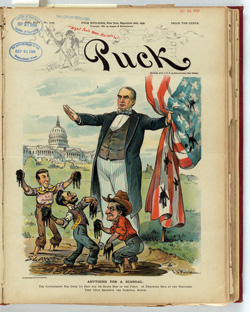
In 1898, Puck depicted President William McKinley standing at the edge of a mudhole labeled “slander” and “abuse,” while William Jennings Bryan, Joseph Pulitzer of the New York World and William Randolph Hearst of the New York Journal throw mud. In 1906, President Theodore Roosevelt coined the term muckraker. Photo courtesy of Library of Congress.
In 1906 President Theodore Roosevelt coined the term muckraker for journalists who were scraping the muck of America and exposing behind-the-scenes information. “Newspapers during this time were tabloids. They would look cheesy to us, but it was news, and not propaganda as it had been before,” Feldstein says.
But with the beginning of World War I and an emphasis on unifying the country, the era of journalistic muckraking gave way to a more subdued journalism. During the decades that followed, international journalism became increasingly relevant, and journalists began to strive for a more “objective” style of reporting.
The 1960s brought intense ideological clashes and the re-emergence of investigative journalism. Journalists exposed and challenged segregation, the Vietnam War, corporate excesses and wrongdoing, and political corruption. But at the same time, publishers feared running investigative pieces because of concerns they could get sued. States had developed their own laws about slander and libel, with the emphasis on protecting public figures from false statements. State laws tended to put the burden of proof on the publishers and journalists.
“Libel laws were the province of the states and provided very little protection for reporters,” Paulson says. “Newspapers owned by families knew that the wrong thing in the wrong story could run them out of business.”
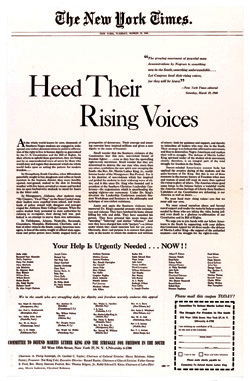
The March 29, 1960, full-page ad that spurred Montgomery, Ala., public safety commissioner L.B. Sullivan to demand a retraction. The New York Time’s refusal prompted him to file the landmark libel suit. Advertisement courtesy of the Library of Congress.
A NEW STATUS QUO
Against that backdrop of state dominance over defamation laws, public unrest and an increasing idealism over the role of reporters, New York Times v. Sullivan took center stage at the Supreme Court, legal historians say.
The case involved a full-page advertisement published in the Times accusing police in Montgomery, Ala., of conducting a campaign to destroy Martin Luther King Jr.’s integration efforts. While most of the descriptions in the ad were accurate, some weren’t. Within days, Montgomery public safety commissioner L.B. Sullivan filed a libel suit against the newspaper.
Under Alabama law, Sullivan didn’t have to prove he had been harmed. In addition, the Times’ only available defense was that the ad was truthful— which it could not use, as the ad contained factual errors. Once some of the information was proven false, intent was presumed under the law.
Sullivan won a $500,000 judgment. The Alabama Supreme Court affirmed. But the U.S. Supreme Court reversed, holding that the right to publish all statements is protected by the First Amendment.
“We hold today that the Constitution delimits a state’s power to award damages for libel in actions brought by public officials against critics of their official conduct,” wrote Justice William Brennan Jr. for the unanimous court. Justice Brennan went on to state that a public official suing for libel or slander must prove that the false statement was made with knowledge of its inaccuracy or a reckless disregard for the truth.
The doctrine was later extended to public figures. No other country has such broad protection for the press when faced with lawsuits by public officials or figures, First Amendment experts say.
“The impact of the case is it became recognized that our libel law was no longer the same, or even similar to, that in England,” Abrams says. “It is surely the greatest libel case in our history, but it is more than that. It is one of the great expositions on the nature of the First Amendment and therefore has impact beyond the field of libel.”
Justice Brennan’s ruling in Sullivan contains broad language on the First Amendment and how public issue debates should be “uninhibited, robust and wide open.” Brennan wrote that the minimum guarantee of the First Amendment was an “unconditional right to say what one pleases about public affairs.”
Since Sullivan, says Paulson, the first question is: “Do we have our facts straight?” The second question is: “Is this a public figure?”
“Sullivan freed up news organizations to pursue the stories that needed pursuing,” says Paulson. “It allows you to write stories about the local [businesspeople] who don’t want you questioning their ethics and stories about the mayor who doesn’t want you to ask about a relative of his who is on the payroll. The large media companies always had high-paid attorneys, but Times v. Sullivan gave weeklies and small newspapers the confidence to report things they might otherwise not have.”
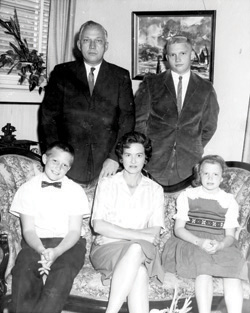
Though not targeted directly in the ad, Sullivan (standing, left) felt his reputation had been harmed. The Alabama Supreme Court awarded him $500,000. Photo courtesy the Birmingham News.
After Sullivan, investigative reporting became, by most accounts, perceived as an important check on government and corporate secrecy and abuse. Certain journalists, like Bob Woodward and Carl Bernstein of the Washington Post, became cultural heroes for exposing government abuse like the Watergate scandal.
Supreme Court rulings at that time appeared to support the notion of the journalist as something of a truth warrior, according to media law experts. In 1971, for example, the Supreme Court ruled that the First Amendment protected the right of newspapers to publish the then-classified Pentagon Papers despite the government’s desire to maintain the secrecy of the information. “At the time, the press was looking fairly heroic in popular culture,” Feldstein says. “So there was a lot of sentiment for a robust press and arguments for why you didn’t want the government stifling confidential reporting.”
In addition, Congress passed the Freedom of Information Act in 1966, which allowed the public increased access to information from federal government agencies.
However, in 1972 the Supreme Court ruled 5-4 that reporters could not use the First Amendment to avoid testifying before a grand jury. The ruling in Branzburg v. Hayes stands as the only time the Supreme Court has directly addressed the question of a reporter’s privilege. “At the time Branzburg came out, it was viewed as a horrible decision for the press because the court essentially ruled that journalists were no different than anybody else and had to supply grand jury testimony,” says Feldstein. “Journalists weren’t special or exempt or immune. But it was a 5-4 decision and [Justice Lewis F. Powell Jr.’s] concurrence—that crucial fifth vote—was more open to the rights of the press.”
Thereafter, federal circuits developed case law sculpting a qualified First Amendment right for journalists to protect their confidential sources. In addition, the majority of states and the District of Columbia have enacted shield laws to protect journalists from being forced to reveal their sources under particular circumstances.
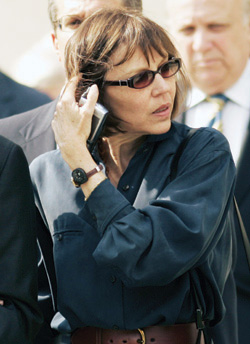
In 2005, Times reporter Judith Miller went to jail rather than reveal a source’s name in court. AP Photo/Haraz Ghanbarl
NEW NORMAL
And then came the Sept. 11th attacks. Since then, the federal government has been attempting to ensure the security of its citizens against the potential threat of foreign or domestic terrorism, legal experts say. Prosecutors have gotten especially tough on anyone who leaks confidential information related to national security.
In pursuing criminal cases against leakers, prosecutors have dragged journalists into court and tapped their phones. In general, judges have supported prosecutors’ efforts at the expense of reporters’ ability to protect their sources.
The first big post-Sept. 11 investigation to ferret out confidential sources concerned disclosure of the identity of Valerie Plame, a covert operative for the CIA.
In 2005 then-New York Times reporter Judith Miller went to jail for contempt of court rather than reveal her confidential source in grand jury testimony.
Before being taken into custody, Miller stated to U.S. District Judge Thomas F. Hogan: “If journalists cannot be trusted to guarantee confidentiality, journalists cannot function and there cannot be a free press.” According to the New York Times, Hogan told Miller: “I have a person in front of me who is defying the law.”
Miller remained in jail for 85 days and eventually testified. In 2006 came the launch of WikiLeaks, a website devoted to publishing secret information. The federal government, waging an ongoing war on terrorism, found itself scrambling to keep classified information from the public.
Since President Barack Obama took office, there have been several cases where federal prosecutors have pursued reporters’ confidential sources.
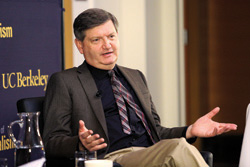
NYT reporter James Risen is under pressure to testify about information leaked from the CIA. AP Photo/Alex Menendez
In May, the Associated Press revealed that the Justice Department secretly obtained two months of reporters’ and editors’ telephone records as part of a criminal investigation into leaked classified information. Investigators seized the records for more than 20 separate telephone lines assigned to the AP and its journalists over the course of two months in 2012.
In another high-profile case, the Justice Department seized email and phone records for James Rosen, Fox News’ chief Washington correspondent. Prosecutors were seeking evidence in their case against former U.S. Department of State adviser Stephen Jin-Woo Kim.
In an application for a search warrant, FBI agent Reginald B. Reyes wrote that there was probable cause that Rosen, by soliciting classified information, had violated the Espionage Act. Reyes described Rosen as an “aider and abettor and/or co-conspirator” in leaking information. The judge granted the application.
And, in a case that could make it to the Supreme Court, the Justice Department has been attempting to force New York Times reporter James Risen to testify in the trial of former CIA intelligence officer Jeffrey Sterling, who has been accused of leaking confidential information to Risen.
In July, in a 2-1 ruling, a panel of the 4th U.S. Circuit Court of Appeals at Richmond, Va., held that the First Amendment did not protect reporters from being forced to testify about people suspected of leaking information to them. The 4th Circuit has declined to hear the case en banc.
“The relationship between the federal government and the media is quite poor right now,” says David Greene, a senior staff attorney with the San Francisco-based Electronic Frontier Foundation. “It’s hard to find a journalist who has good things to say about the Justice Department.”
Justice already had set guidelines for when journalists’ records should be obtained to restrain prosecutors from seeking them unless they were necessary for a criminal investigation. But after criticism from lawmakers and the media, the department has tightened its standards for gathering data from reporters.
U.S. Attorney General Eric H. Holder Jr. announced in July that it had new, tighter guidelines. One change said the government must give advance notice to the media about subpoena requests unless the attorney general finds “compelling reasons” that the notice would pose a clear and substantial threat to the integrity of the investigation. Previously that decision had been in the hands of the head of the criminal division and simply reviewed by the attorney general.
CHECKS AND BALANCES
The revised guidelines make it harder for prosecutors to obtain the telephone records of journalists without advance notice, thereby allowing news organizations the opportunity to contest the intrusion in court.
The guidelines also prevent investigators from portraying a reporter as a criminal co-conspirator to circumvent rules preventing the search or seizure of reporter work product.
Certainly, some free speech advocates say they are concerned that recent developments depict a trend toward muzzling—or attempting to muzzle—journalists who uncover secrets or information the government is attempting to minimize or silence.
“Clearly the Obama administration has been very aggressive in leak cases,” Cope says. “Oftentimes the prosecutors are going straight to the reporters to make them reveal their sources, instead of following Justice Department guidelines that say reporters should be the last resort.”
More recently, Congress has thrown itself into the mix, proposing and discussing a federal media shield law to help journalists protect the identities of their confidential sources. As of the Journal’s press date, the bill had yet to go to the Senate floor.
Pozen questions the need for a federal shield law at all, pointing out that last year’s AP scandal resulted in outrage and then government backtracking on its methods of investigation.
“The existing methods for accountability have actually worked quite well,” Pozen says. “In the case of the AP reporters, the Justice Department’s actions triggered a major backlash and the Justice Department responded with a tightening of its guidelines. That’s a form of accountability in action.”
For Cope of the Newspaper Association of America, the recent cases with Justice show the need for a shield law. Without it, reporters do not appear to have a guaranteed reporter’s privilege under the law, and the safety of confidential sources is in question, she says. “It’s hard to say what stories have not come forward because sources are afraid, but there’s no doubt that there’s been a chilling effect because federal protection is weak.”
WHO’S COVERED?
Some critics are concerned about the bill’s changing definition of a “covered reporter.” At first, there were objections that journalists who weren’t considered “real journalists” were being covered. Since then, the bill has been rewritten to exclude individuals whose principal activity is disclosing unauthorized documents, but to include freelance writers as well as journalists on staff at both large and small news agencies.
In addition, judges can find that journalists are covered if doing so would serve the “interests of justice.” Critics say that the new definition is confusing and vague.
In his editorial, former U.S. Attorney General Mukasey said the bill would allow judges too much discretion in determining what constitutes a threat to national security.
“What is or isn’t in the public interest, how grave may be the national security threat from letting a reporter shield a confidential source, and determining what is ‘essential’ to an investigation is left to the unguided discretion of each judge who hears such a case,” Mukasey wrote. “Judges—who are neither trained to assess national security threats nor generally responsible for such assessments—thus supplant executive officials who have the training and the responsibility.”
But Pozen says that judges are far from reliable supporters of the media when national security appears to be at stake.
“If you think that journalists are just getting clobbered right now by the federal government and that that’s because they lack the First Amendment protection to withhold information, then the idea of a shield law is intuitively appealing,” he says. Pozen adds that “one reason why it seems so natural for members of the media to seek this kind of legislation is they assume when given a role by statute to review executive branch efforts to subpoena journalists, the courts will be careful to safeguard the media’s interest. But it’s not clear to me that judges would do that.”
This article originally appeared in the March 2014 issue of the ABA Journal with this headline: “A Weakened Shield? Fifty years after New York Times v. Sullivan, journalists wonder whether courts still value their watchdog role.” Last updated Feb. 28 to correct a spelling error.
Anna Stolley Persky is a freelance writer based in Washington, D.C.



